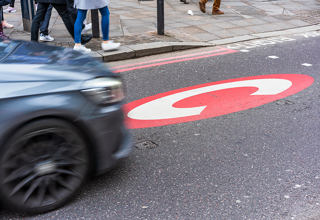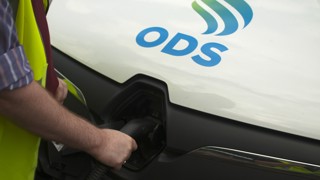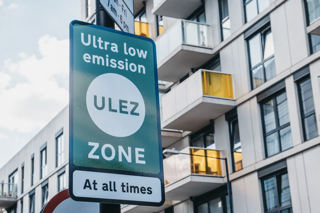Fleet News collates the purpose, the plans, the goals - and an interactive map - of the UK's Clean Air Zones.
What is a Clean Air Zone?
A Clean Air Zone is defined an area where targeted action is taken to improve air quality.
It can be confined to a single road or a part of a city.
This can include an area in which vehicles can be charged or fined for entering.
Why is the Government introducing Clean Air Zones?
The Government has a long term strategy to improve air quality across the country by discouraging the use of older, more polluting, vehicles and has a short term goal to reduce the number of areas in the UK where air pollution breaches legal limits.
What areas will be targeted by Clean Air Zones?
Five cities have been mandated by the Government to introduce a Clean Air Zone, these are Birmingham, Leeds, Nottingham, Derby and Southampton.
The Government has also named 23 local authorities where it expects pollution levels to reach illegal levels by 2021. They must all carry out a feasibility study to determine whether or not a Clean Air Zone is required.
How will Clean Air Zones be introduced?
Local authorities are responsible for the implementation of clean air zones.
Each Council was asked to create an Air Quality Improvement Plan and submit it to Government by March 2018.
Once approved, the local authority can receive funding to help set up the zone.
What vehicles will be affected by the Clean Air Zones?
Local authorities can decide what level of restriction to apply.
There are four classes of Clean Air Zone:
1. Class A - Buses, coaches, taxis and private hire vehicles
2. Class B - Buses, coaches, taxis, PHVs and heavy goods vehicles (HGVs)
3. Class C - Buses, coaches, taxis, PHVs, HGVs and light goods vehicles (LGVs)
4. Class D - Buses, coaches, taxis, PHVs, HGVs LGVs and cars
Buses, coaches and HGVs that meet Euro VI emissions standards must be exempt from any charges or restrictions.
Cars, vans and taxis that meet Euro 6 (diesel) or Euro 4 (petrol) emissions standards must be exempt from any charges or restrictions.
Ultra-low emission vehicles with a significant zero-emission range must be exempt from and charges or restrictions.
How much will it cost to enter a Clean Air Zone?
Charging is not compulsory. Local authorities will only be able to set charges at levels designed to reduce pollution, not to raise additional revenue beyond recovering the costs of the scheme.
UK Clean Air Zone plans - interactive map.
Zoom in and click on the area you're interested in to see details on clean air zone proposals
Map key:
![]() Clean Air Zone expected or being planned
Clean Air Zone expected or being planned
![]() Area required by government to produce a CAZ plan
Area required by government to produce a CAZ plan
![]() CAZ not expected or opposed by local authority
CAZ not expected or opposed by local authority
What cities are involved in introducing a CAZ?
Five cities have been mandated by government to introduce a Clean Air Zone
Birmingham
CAZ expected by 2020
Birmingham is proposing a Class D CAZ.
Charges would apply to the most polluting vehicles which enter the CAZ, including buses, coaches, lorries, taxis and private hire vehicles, vans and private cars.
In Birmingham, it is proposed that the CAZ should cover all roads within the A4540 Middleway ring road. It will be policed with automatic number plate recognition cameras and the council has asked for £24 million in Government funding to set this up.
The proposed charging scheme will be between £6 and £12.50 a day for private cars, £12.50 for light commercial vehicles over 3.5 tonnes, £12.50 for taxis and private hire vehicles, £50 to £100 for HGVs, including buses and coaches. Failure to pay will result in a £120 fixed penalty fine.
Part of Birmingham's strategy also includes limiting taxi licences to those with ultra-low emission vehicles, adding 200 additional charge points and investing in a fleet of 22 hydrogen buses to operate in the city. The council is also looking at setting up a leasing scheme for taxi drivers to switch to an ultra-low emission vehicle or convert their existing vehicle to LPG.
Derby
CAZ not expected
The council is proposing traffic management measures to address air quality issues without any charges for road users.
The current plan is to introduce a traffic management/signal scheme to help reduce traffic flows through Stafford Street near the city centre to help address the air quality issues that have been identified in that location.
This will involve limiting the traffic in Stafford Street and redistribute it to others parts of the highway network.
In addition there will be a need to implement a new urban traffic management and control system across a wider area of the city, which will optimise traffic flow on adjacent routes.
Derby is also looking to introduce a scrappage scheme that would see drivers dispose of older more polluting vehicles in exchange for credits for free travel on public transport, car club credits, money towards an ultra-low emission vehicle or a smaller subsidy to help fund the move to a Euro 4 petrol or Euro 6 diesel vehicle.
These grants are proposed to be available alongside existing plug-in vehicle grants. It is also planning to introduce an initiative to help businesses switch to ultra-low emissions vehicles and to increase the number of charge points across the city.
Leeds
CAZ will be introduced in January 2020.
The zone covers all roads within the boundary of the A61 and A63, near Leeds city centre. It will be policed with automatic number plate recognition cameras. Leeds has asked for £40 million to implement its plans.
There will be a further £24m to help taxi drivers switch to ultra-low emission vehicles.
Private car drivers won’t be charged, but buses, HGVs, taxis and private hire vehicles that fail to meet the required emissions standards will have to pay a daily fee to enter the zone.
This which would include charges of £50 per day for EU5 or earlier diesel buses and coaches, £50 per day for EU5 or earlier diesel HGVs and £12.50 per day for EU5 or earlier diesel or EU3 or earlier taxis or private hire vehicles.
Additional measures to improve air quality include encouraging voluntary movement to alternative vehicles and moving private taxis from Euro 6 to hybrid and electric.
Nottingham
CAZ not expected
Nottingham City Council has cancelled its plans to introduce a clean air zone (CAZ).
The council now believes that it can be compliant with air quality regulations by 2020, thanks to a range of environmental projects, which include retrofitting 171 NCT buses with clean exhaust technology, requiring every taxi and private hire vehicle in the city to be low emission, and the council replacing its own heavy vehicles – such as bin lorries – with electric or other low emission vehicles.
The Government will make £1m available to provide licensing discounts for drivers that switch to low emission vehicles, they will install a taxi rank with charging points, fund home chargers for taxi drivers and expand its "try before you buy" scheme, which started in November 2018.
Southampton
CAZ charging expected in 2019
Southampton introduced a Clean Air Zone on a non-charging basis in 2017.
Southampton City Council will submit their CAZ plans by the end of January 2019.
The council's plans include favouring a ‘Class B CAZ’, which would see buses, coaches and heavy goods vehicles (HGVs) below the Euro VI emissions standard charged up to £100 per day to enter the CAZ. Southampton is also proposing that private hire vehicles and taxis below Euro 6 diesel and Euro 4 petrol will be charged £12.50 per day to operate within the zone.
Proposed boundaries for the Southampton CAZ will be confirmed at the end of January 2019.
London
ULEZ from April 2019
London is introducing an Ultra Low Emissions Zone (ULEZ) affecting all vehicles entering central London.
The area covered by the ULEZ is the same area as the Congestion Charging Zone
The ULEZ will operate 24 hours a day, every day of the year, including weekends and public holidays.
The ULEZ standards are:
- Euro 3 for motorcycles, mopeds, motorised tricycles and quadricycles (L category)
- Euro 4 for petrol cars, vans, minibuses and other specialist vehicles
- Euro 6 for diesel cars, vans and minibuses and other specialist vehicles
- Euro VI for lorries, buses and coaches and other specialist heavy vehicles
Charges: £12.50 for cars, vans and motorcycles; £100 for buses, lorries and coaches.
London boroughs
Hackney and Islingston
Hackney and Islington Councils are currently consulting on a new scheme which could see all but the cleanest vehicles banned from two zones in Shoreditch.
It proposes a ban on any vehicles emitting more than 75g/km of CO2 from entering nine streets between 7-10am and 4-7pm, Monday to Friday.
The consultation states that businesses and residents located in these zones will be able to register for an exemption.
Kensington and Chelsea
Proposals to extend the London Ultra-Low Emission Zone (ULEZ) to the North and South circular roads are being supported by Kensington and Chelsea council. Cars, vans and motorbikes that don’t meet emission regulations would have to pay a daily charge of £12.50 from October 2021 to drive within the ULEZ if the proposals are approved.
Clean Air Zone proposals by city
Basildon
CAZ opposed
Basildon and Rochford Councils have been told by the Government that they must consider a CAZ to address two areas of illegal pollution by 2020.
The councils are fighting the order which, if implemented, could impose restrictions on the A127.
The council is proposing a new cycle route and £470,000 of investment for rapid charging points as an alternative to a CAZ.
Bath
CAZ expected by the end of 2020.
Proposals would see a Class D charging CAZ in the city centre by the end of 2020.
Currently in Bath diesel and petrol cars emit 33% of nitrogen oxides (NOx) which is more than is contributed by LGVs/vans (16%), buses and coaches (32%) and lorries (19%).
Research shows that around 75% of vehicles should already be compliant by 2021 and a raft of exemptions and concessions are also being proposed. This means that a substantial proportion of drivers would be able to travel in the zone without paying a charge.
The remaining drivers would have to switch to lower emission vehicles “or find alternative ways to get around that they are happy with”.
Bristol
CAZ expected 2019
Bristol city council has outlined five potential options for the establishment of a clean air zone within the city.
The options include a small or medium-sized Class C or Class D charging clean air zone in the centre of the city, which could levy a charge for the use of buses and coaches, taxis and private hire vehicles, heavy and lights goods vehicles, and potentially also private cars.
It will be consulting on the options next year and is also calling on the Government to help fund and introduce a national "vehicle renewal scheme" to help meet pollution targets.
Cambridge
CAZ expected: date TBC.
Cambridge City Council is currently evaluating a Clean Air Zone within the existing Air Quality Management Area in Cambridge, which includes the trafficked parts of the historic core and the inner ring road.
It has not made a decision on whether the zone will be chargeable or which types of vehicle it will seek to restrict.
The council will also look to reduce HGV emissions in the city centre by promoting greener methods for making deliveries of goods, such as by cycle.
Other proposed policies include incentives for electric or hybrid taxis and reducing bus and coach emissions by working with partners to invest in more environmentally-friendly vehicles.
Canterbury
CAZ not expected.
Canterbury City Council is planning to reduce emissions by adopting strict anti-idling enforcement which would be encouraged at coach parks, on-street parking bays, taxi ranks and at level crossings.
The council will also explore the use of its fee structure to encourage taxi drivers and bus companies to use low-emission vehicles.
Council officers will seek to work with freight companies to encourage them to use the right routes around the city and promote better driving.
Exeter
CAZ not expected.
Exeter City Council does not intend to introduce a CAZ or apply access restrictions or limits to the age and type of vehicles which can enter certain areas of the city.
In its Air Quality Action Plan the council says that it aims to discourage private car use and increase use of public transport, cycling and walking.
The Plan concentrates on improving air quality in the Air Quality Management Area, particularly in Heavitree where the highest levels of pollution are measured.
Leicester
CAZ expected by 2026.
Leicester City Council is seeking to deliver a clean air zone by 2026 or sooner.
By 2020 it expects to implement a Clean Air Zone for buses only.
Liverpool
CAZ expected: date TBC
Liverpool City Council is currently assessing the viability of a chargeable Clean Air Zone but has not outlined any formal details.
Liverpool’s Mayor has previously suggested a blanket ban on all diesel vehicles entering the city.
The council has already proposed to enforce anti-idling fixed penalty notices using local authority officers. Liverpool City Council is also switching its city centre fleet to be diesel free from 2020, followed by council vehicles used across the wider city from 2024.
Manchester
CAZ not defined.
Greater Manchester’s Mayor Andy Burnham has said that no private vehicle charging scheme will be implemented as part of any air quality measures. However, a Transport for Greater Manchester suggested a CAZ is still under consideration but will likely apply to private-hire vehicles, buses and HGVs.
Other measures include a workplace parking levy, incentives to help uptake of electric vehicles in the city and converting public transport and local authority fleets to be low emissions.
Manchester has also called for a scrappage scheme to help incentivise drivers of older diesle vehicles to switch to an ultra low emissions model. Air pollution plans are due to be outlined by January 31, 2019.
Newcastle
CAZ not expected.
Newcastle-under-Lyme Borough Council has ruled out Clean Air Zones, saying it will build on existing policies in the city to promote alternative modes of transport to the car.
The council’s draft air quality plan is currently under review but is likely to include measures to improve emissions on the A167 north of and over the Tyne Bridge, large sections of the western bypass (A1) and the Coast Road (A1058). Newcastle is expected to submit its proposals for an alternative to CAZ to Defra before the end of 2018.
Oxford
Zero emissions zone planned for 2020.
Oxford City Council is planning to ban all petrol and diesel vehicles from Oxford City Centre by introducing a Zero Emissions Zone. Any other vehicle planning to visit the city centre will have to use Oxford's park and ride facilities.
The plans - which are out for consultation - suggest the ban would be introduced in phases, starting with preventing non-zero-emitting taxis, cars, light commercial vehicles and buses from using a small number of streets in 2020.
The zone will gradually extend to cover all non-electric vehicles, including HGVs, in the whole of the city centre by 2035.
Sheffield
CAZ planned for 2020.
There are no plans to charge private cars, but the most polluting buses, taxis, lorries and vans will be charged for entering a zone on the inner ring road surrounding the city centre.
Proposed charges are £50 a day for buses, coaches and HGVs, £10 a day for taxis and private hire vehicles and £10 a day for vans and light commercial vehicles above 3.5 tonnes.
Sheffield Council is seeking £40 million in Government funding to support affected businesses and taxis to help upgrade their vehicles.
The council will launch its consultation on the plans in early 2019 and measures will be introduced the following year.
St Albans
CAZ under consideration.
St Albans City & District Council is considering plans to set up Clean Air Zones in areas where the air quality is poor, or vulnerable people are concentrated.
The scheme is likely to concentrate on fining drivers for excessive idling.
Warrington
CAZ under consideration.
Warrington Borough Council will examine the potential benefits and drawbacks of introducing a Clean Air Zone.
It has already adopted its five-year plan to tackle pollution, which includes measures such as increasing the use of electric vehicles and establishing new cycling and walking links.
Wokingham
Low Emission Zone under consideration.
Wokingham Borough Council has published its Air Quality Action Plan, which highlights two locations where emissions levels need to be reduced - Wokingham town centre and Twyford Crossroads.
The plan outlines the potential for a Low Emission Zone within the borough, although the Council has not stipulated how this will operate.
York
CAZ proposed for buses.
York City Council plans to implement a Clean Air Zone for buses, targeting an area within York’s inner ring road and city centre.
It will limit the frequency that buses can enter the zone, based on the emissions performance of the bus.
Current proposals suggest that buses entering the targeted zone 10 times per day or more must meet a minimum of the Euro 6 emissions standard by 2020. York is also looking to convert 17% of taxis to electric hybrids. There will also be a new taxi licencing policy in place to specify minimum emissions standards.
Local authorities required by government to produce a local action plan this year
- Bolton Borough Council
- Bury Borough Council
- Coventry City Council
- Fareham Borough Council
- Gateshead Borough Council
- Guildford Borough Council
- Middlesbrough Borough Council
- North Tyneside Council
- Rochford Borough Council
- Rotherham Borough Council
- Rushmoor Borough Council
- Salford Borough Council
- Stockport Borough Council
- Surrey Heath Borough Council
- Tameside Borough Council
- Trafford Borough Council
Scotland
The Scottish Government has outlined plans to have four Low Emission Zones (LEZ) in operation by 2020, with the first to be established in Glasgow by the end of 2018.
Alongside Glasgow, LEZs are also expected to be introduced in Edinburgh, Aberdeen and Dundee.
The proposals in Glasgow include an initial focus on securing cleaner bus services within the city, in an area currently covered by the city’s air quality management area, from the end of 2018.
A second phase is likely to cover other vehicles and will be consulted on over the course of the next 12 months.
As part of the consultation, the Scottish Government suggested a minimum standard of Euro 6 for diesel cars, Euro 4 for petrol cars and Euro VI for buses – the proposal was backed by 62% of respondents.
Some three quarters of respondents agreed that emission sources from construction machinery and/or large or small refrigerated units should be included within the scope of LEZs.
Wales
The Welsh Government is seeking views on its Clean Air Zone proposals, which include charging the most polluting vehicles for entering certain parts of its cities.
Cardiff has ruled out a CAZ but is instead looking to impose alternatives like speeding restrictions, increasing the number of zero emission buses on the Cardiff network, improving taxi licensing policy to set minimum vehicle emission standards, accelerating Park & Ride programmes and improving and promoting the uptake of low-emission vehicles by investing in Cardiff’s electrical charging infrastructure.
Caerphilly is looking to introduce a Clean Air Zone on the A472 at Hafodrynys Hill and a total ban on HGVs at peak times in the area. Plans will need to be submitted to the Welsh government by June 2019.
The Welsh Government has said it will encourage local authorities to introduce clean air zones, where evidence suggests they are needed to reduce harmful emissions
Temporary speed limits (50mph) have also been introduced to reduce emissions at five locations:
- A494 at Deeside
- A483 at Wrexham
- M4 between Junctions 41 & 42 (Port Talbot)
- M4 between junctions 25 & 26 (Newport)
- A470 between Upper Boat & Pontypridd
Cardiff Council has already agreed to conduct a feasibility study to determine if a CAZ is needed in the city.
Not mentioned?
If you have any details of plans not covered in the map, please let us know at: fleetnews@bauermedia.co.uk





















Login to comment
Comments
No comments have been made yet.